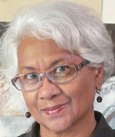 E. Ratnam Keese, author of The Fence
E. Ratnam Keese, author of The Fence
What inspired you to write this story?
In writing ‘The Fence’, which is based on an actual event —conflict over the demolition and installation of a fence between two properties— what inspired me was the theme that finally emerged: that to love is to be supportive. This philosophy is demonstrated in my story on different levels: between each of the two couples; between the two women, and between man and landscape. Communications either work or break down on account of this philosophy for which the fence becomes the metaphor.
What do you like about the long story form?
I like the focus and compactness of the long story, and how the form itself allows time for the exploration of levels of meaning and space for the introduction of a motif to reinforce the theme. For example, in John Steinbeck’s Of Mice and Men, the motif —putting down Candy’s old dog for its own good— on which the narrative hinges, drives the reader gently towards the realisation of the central theme of the story. In Jorge Luis Borges’s Emma Zunz, the degrading situations to which Emma subjects herself are the collective motif which grooms her for the final revolting act she is compelled to commit in her quest for revenge. I also like the irony of the long story where events related which seem insignificant, in the end suggest a deeper level of meaning to the reader, and it is this meaning which remains an indelible memory.
The Carmel Bird Long Story Award was open to women writers only – how does the fact that you are a woman writing in contemporary Australia impact on you and your writing?
As a woman writing in contemporary Australia I write in the belief that writing is a mentally and spiritually stimulating activity which is open to all regardless of race, gender, colour, creed or age. At least that’s how it should be. The other side of the coin of exclusion is ghettoization. I take courage from the thought that there are and have been great women writers in Australia and in the world who have been recognised despite the absence in their time of special privileges. However, the generalisation that women’s writing is no different from men’s ignores the obvious: that the themes and the concerns in women’s writing can sometimes differ from men’s concerns. The ideal would be the validation of the vitality of these themes, not through isolation and exclusion but on the level and open field of all writing.
How does your usual writing process work? Where do the ideas for your stories come from?
I create a museum of ideas and images from real life through travel diaries, visual diaries and journals. I store snippets of poetry and conversations which I might have overheard or remembered from childhood by writing them down. I write close accounts of the things that affect me during the day and some of these encounters have returned in my writing. I often begin with a real life experience which gradually metamorphoses into something entirely different as the characters become hybridised and decide to do other things.
One example of a story I once wrote began with something I heard about in childhood of a man who locked himself in his own house where he slowly went mad. I imagined that all he did was walk from room to room all day. Later this image came back to me when I saw images of flooded houses in Queensland. I had said he was a voyager in his own house and so I made him row himself in a dinghy from room to room in a house filled with water. In one room he works his way through a seemingly impenetrable Malaysian jungle until he comes to a clearing where he sees a tabernacle of pink glass floating in a small blue lake. This image and the verbal depiction of this room and this edifice came from Hieronymus Bosch’s The Garden of Earthly Delights.
I am yet to continue writing this story which lies dead somewhere but might be resurrected at some stage.
What writers do you turn to when you’re feeling uninspired? Do you have any tricks for getting motivated?
I have no tricks to get motivated because I am lucky to be able to move seamlessly between a visual arts practice and writing. Sub-consciously, one inspires the other. But I do often turn to Jorge Luis Borges. The stories in Labyrinths are endlessly fascinating and inspiring. I also turn often to Italo Calvino, to his Six Memos for the Millenium and Under the Jaguar Sun. From time to time I re-read the stories in Raymond Carver’s Where I’m Calling From and I dip into Francine Prose’s Reading like a Writer.
E. Ratnam Keese is a Visual Artist and writer. In 2012 she was shortlisted for the Calibre Prize for Mapping the Edges of the Night and long listed for the Carmel Bird Long Story Award for The Fence.
Book available in ePub and mobi formats at Tomely

